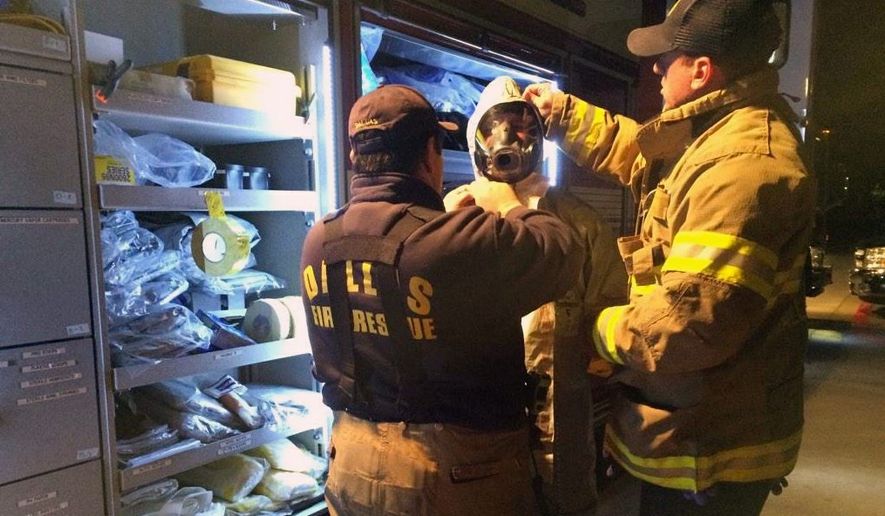The Centers for Disease Control told the incoming Obama administration in 2008 that it should establish 18 regional disease detection centers around the world to adequately safeguard the U.S. from emerging health threats like Ebola, according to an agency memo.
But six years later, as the government struggles to contain the fallout from a deadly Ebola outbreak at home and abroad, the CDC still has only 10 centers — and none of them operates in the western Africa region hardest hit by the deadly virus.
“The existing centers have already proven their effectiveness and impact on detecting and responding to outbreaks including avian influenza, aflatoxin poisoning, Rift Valley fever, Ebola and Marburg virus outbreaks,” the CDC said in its memo to the Obama transition team, which The Washington Times obtained through a Freedom of Information Act request.
At the time, the CDC had five centers set up, and has only added five more of the 13 the agency had proposed “to complete the network and properly protect the nation.”
The memo sheds new light on the problems dealing with the current Ebola crisis, which intensified with the revelations Wednesday that a second Texas nurse had tested positive for the disease and President Obama used a White House Cabinet meeting to promise a “more aggressive” federal response to the threat.
The CDC’s plan outlined in the transition memo was based on the notion that the U.S. shouldn’t wait for a disease to enter the country but rather monitor threats in hot spots overseas to try to help local public health authorities control outbreaks before then.
PHOTOS: See Obama's biggest White House fails
The CDC didn’t respond to messages seeking comment on its plans Wednesday.
On its Web page, the agency said it has eight regional centers running, with another two in development.
Aside from detecting and monitoring diseases, the centers also provide education to local public health authorities. Though the CDC operates three response centers in Africa — in Kenya, Egypt and South Africa — none of those are based in the western parts of the continent that have seen major Ebola outbreaks this year.
News on Wednesday that another patient in the U.S. — a second health care worker who treated an Ebola patient in Texas — may be infected prompted calls for tightened travel restrictions and at least a temporary travel ban for Liberia, Guinea and Sierra Leone, including one from House Speaker John A. Boehner, Ohio Republican.
The administration has so far rejected those calls, with health officials saying they fear the bans could prevent them from getting aid workers and medical assistance to and from Africa.
Meanwhile, the fight over funding for anti-Ebola efforts has turned political.
PHOTOS: Eye-popping excuses in American political scandals
Fights over funding
Five Democratic House members on Wednesday called for hearings into budget cuts at the National Institutes of Health and CDC.
The lawmakers said NIH has lost $1.2 billion in funding over the last four years and that a CDC program that supports public workers was slashed 16 percent during the past four years, while a hospital preparedness program lost 44 percent of its funding.
“The CDC and the NIH are already working to combat the spread of Ebola,” said Rep. Michael M. Honda, California Democrat. “In light of recent tragic developments in Texas, and in the interests of ensuring public safety and transparency, we need an update from these agencies so we can ensure they have the proper funding to protect patients, health care workers and the public at large.”
As the deadly virus continues to spread, the CDC has sent dozens of disease control experts into western Africa. In a recent budget document, the agency also has said it’s seeking an extra $45 million for global health security “to accelerate progress toward a world safe and secure from infectious disease threats.”
But the agency’s own memo to the president’s transition team highlighted the need for beefed-up infectious disease detection and other public health efforts overseas. It also reflects funding concerns during the George W. Bush administration.
“Our investment is modest,” the CDC memo stated, “but our capacity in most critical areas has been eroded by budget attrition and increases in the cost of science, travel and infrastructure support in recent years.”
The comments were included in the appendix to the agency’s 128-page briefing memo to the transition team. That same portion of the report had been sent in 2007 to a House appropriations subcommittee overseeing CDC funding, according to the transition memo.
The memo also stated that “core funding” for noninfluenza infectious diseases was lacking, “leaving us many millions behind where we were five years ago when adjusted for inflation.”
“Programs for rabies, rotavirus, food safety, special pathogens like Ebola virus and many others need immediate support if they are to sustain their baseline capabilities.”
The White House and CDC have both cited the regional response centers in recent weeks as an example of the administration’s Ebola response.
Neither the White House nor the Department of Health and Human Services, which oversees the CDC, responded to messages about the recommendation for 18 regional centers.
Senate Health, Education, Labor and Pensions Committee Chairman Tom Harkin, Iowa Democrat, said in a recent floor speech that he’s worked for years to secure more funding for CDC disease detection centers overseas.
“We must stop chasing diseases after the fact and start building public health systems capable of detecting and stopping diseases before they cross borders,” Mr. Harkin said.
The transition memo sounded a similar warning to Mr. Obama’s team as the president prepared to take power in late 2008: “Our nation’s preparedness has greatly benefited from government investments in terrorism and pandemic influenza preparedness, but recent events illustrated that vulnerabilities remain.”
• Jim McElhatton can be reached at jmcelhatton@washingtontimes.com.




Please read our comment policy before commenting.